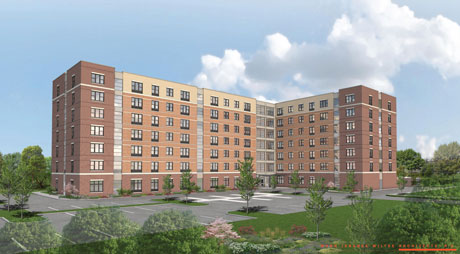Although underwriting is more stringent than before the pandemic, lenders and investors are still showing a strong interest in seniors housing.
By Jeff Shaw
Seniors housing has clearly endured a rough ride as a result of the COVID-19 pandemic. But that doesn’t mean that investors, lenders, developers and owners don’t see value in it.
“Value is the worth of all benefits arising from ownership,” said JP LoMonaco, president of Valuation & Information Group. “It is by nature a long-term concept. The value isn’t determined by benefits derived today or over the last week, but the anticipated benefits of ownership over the long term.”
This view of value is encouraging to players in the seniors housing space, as most believe the pandemic is a short-term disruption rather than any sort of long-term collapse.
LoMonaco’s comments came during a webinar panel he moderated on Jan. 28, titled “Seniors Housing Valuation Outlook: What’s Ahead for 2021?”
France Media, InterFace Conference Group, Seniors Housing Business and Valuation & Information Group collaborated to present the free webinar. Panelists included Bill Pettit, president of R.D. Merrill Co.; Rich Lerner, partner with Housing & Healthcare Finance; Adam Heavenrich, managing director of Heavenrich & Co.; Michelle Kelly, senior vice president of investments at National Health Investors (NYSE: NHI); and Chris Kronenberger, managing director of investments at Blue Moon Capital Partners.
While seniors housing development and acquisitions are still occurring, the pandemic has slowed the velocity of deal making in the marketplace. Acquisition volume fell 48 percent from 2019 to 2020, according to Real Capital Analytics. New construction as a percentage of existing inventory fell from 7 percent in fourth-quarter 2019 to 5.5 percent in fourth-quarter 2020, reports the National Investment Center for Seniors Housing & Care (NIC). Before the pandemic hit, new construction starts were already at the lowest rate in six years.
“A lot of the investors are waiting for a few things: They want to see how the vaccine rollout goes and they want to see if NOI (net operating income) will start to grow,” said Kronenberger. “Once equity investors see buildings open up and residents having visitors, you’ll see the transaction market start to pick up again.”
Heavenrich noted that investors have much more “sober underwriting,” saying that “equity is being more selective.”
Public companies like NHI found themselves temporarily handcuffed by low stock prices as the pandemic took hold. NHI’s stock price fell from $90.79 per share on Feb. 21, 2020, to $37.82 on March 20, 2020, before leveling out in the $60 to $70 range (The price was $69.74 per share on March 4, 2021).
“Our cost of capital is very much tied to our stock price,” said Kelly. “We’re looking at new transactions, but we’re definitely more cautious in terms of how we’re underwriting cash flow. We’re trying to think about what is a real number that can support a rent payment in a triple-net lease structure.”
Reasons for optimism
Despite these negative indicators, Lerner said lenders are still “full speed ahead” for providing capital in seniors housing.
“They’re being more careful. They’re scrutinizing deals more than before, but they are doing deals.”
Lerner noted that HUD and the agencies, Freddie Mac and Fannie Mae, have continued to be very active in lending, particularly for the skilled nursing end of the spectrum.
“We’re seeing lenders willing to write significant debt in the 65 to 70 percent range at a percentage over LIBOR, and we’re seeing active mezzanine players. We’ve got transactions in the $200 million to $400 million range that are getting multiple bids. The equity is there and the debt is there.”
Lerner added, however, that “some players have left” on the lending side, and that almost all loans for skilled nursing are bridge-to-HUD loans.
For its part, R.D. Merrill Co. raises its own capital through high-net-worth individuals, then partners with institutional capital, said Pettit. Despite the slowdown in construction starts, he said the company is “still finding real interest in development, particularly for projects that will deliver two to three years out.”
“On the acquisitions side, there’s capital available particularly for distressed situations we might look at — and we will see more of that as the market progresses,” added Pettit.
He did note that capital sources for development have tightened underwriting. While Merrill is “pretty conservative” by seeking a 65 percent loan-to-cost ratio, many lenders are now more comfortable with 55 percent, said Pettit.
“They’re being cautious, but loans are still available. Our access to capital is more fluid on the equity side than it is on the debt side.”
Blue Moon raises its capital largely from institutional investors like public pension funds, then augments that capital with debt, said Kronenberger. The private equity firm has continued to participate in both acquisitions and new development, including making one of the largest purchases of the year, buying 10 communities from Healthpeak Properties for $350 million.
“Loans have started to open up in the permanent financing markets,” said Kronenberger. “You can still get really good terms if you’re looking at moderate leverage. So that is certainly helping the industry.”
“For bridge financing, if your property’s not cash flowing it could present some challenges,” he continued. “You won’t see pre-pandemic terms. There’s lower loan-to-value ratios, more recourse and maybe some reserves you have to account for.”
On the construction lending side, Kronenberger noted that regional banks have stepped up to fill in some of the gap left by national banks that have backed away from the table.
What’s more, private equity investors “were sitting on a lot of equity, waiting to invest” when the pandemic broke out, noted LoMonaco. “That dry powder is still out there.”
Overall, the panelists expressed optimism that the capital markets will return to a relatively normal state once the effects of the COVID-19 vaccine take hold and occupancy begins to increase.

